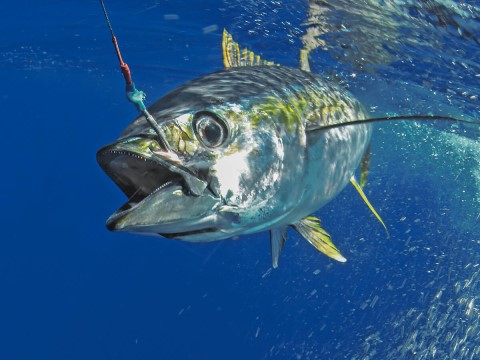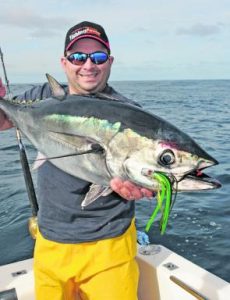How to Catch Yellowfin Tuna Trolling
Yellowfin Tuna, also known as Thunnus albacares, is a species of tuna that is deep blue on top, has a shallow yellow line all the way to the tail in the middle and their fins are yellowish color. Yellowfin is one of the larger tuna species with the potential of reaching up to a weight of 180 kg. They are mainly found in the offshore waters such as Gulf of Meixco, Hawaii, Caribbean, Eastern and Western Pacific.
Trolling for Yellowfin Tuna
Yellowfin Tuna usually travel in large schools to the surface during feeding time. They are boat shy and will quickly dive deep into the water when they see a boat approaching. Therefore, upon spotting the school of tuna from afar, you must not steer your boat fast toward them otherwise they will swim away. The strategy to catching tuna is to stop your boat a distance away from the fish for example, 3 knots away. Then, you can put out your fishing line and let the bait float itself to where the school of tuna is.
When you stop your boat, the engine stops producing noises and the fish will be more bold to swim near your boat. Parking your boat a distance away prevents the tuna from associating the bait comes from your boat. Hiring a big fishing charter will give you a better fishing experience. When you reel in the fish, the fish will jump and flip and you will have fight the fish until it is dead. If your fishing charter is small and there is not enough room, you may accidentally step on your expensive fishing rig or even fall out of the boat.
Learn more about the Yellowfin Tuna Species
Ideally, your fishing charter should be large enough to set up 6 – 7 flush mount or vertical fishing rods. The more fishing rods you set up, the higher the chance of catching the tuna. After you stop the boat afar, you just wait patiently. You may have to wait up to 7- 8 hours for the first bite but it is worth the wait. While waiting, you must stay alert and quickly pull in the rod when you sense something bites. It is important to always wear thick buckskin glove when pulling in the rod. It will protect the skin on your palm and finger from callouses as you need a lot of strength to pull in the rod.
Cedar Plugs Tuna Fishing Lures
It is best to go fishing for yellowfin tuna with 1 or 2 partners as they can give you additional hands in catching the fish. For example, your partner can help with storing the rod in a cabin space or help you in getting the fish into the boat. Lures like tuna feathers, cedar plugs, chain, joeschutes and sterling bars can be used. For catching yellowfin tuna, the boat should be trolling at the speed of 5 – 8 knots. You can adjust your boat speed according to the behavior of the lure. Rougher seas mean you have to troll at a slower speed to enable the lure to work the most efficiently.
Stay tuned for more tips and tricks on How To Catch Tuna.

 Penn Tuna Fishing Rod & Reel Combo
Penn Tuna Fishing Rod & Reel Combo Cedar Plugs Tuna Fishing Lures
Cedar Plugs Tuna Fishing Lures View Best Tuna Fishing Lures
View Best Tuna Fishing Lures Stainless Steel Fishing Leaders
Stainless Steel Fishing Leaders Fishing Rod Holder
Fishing Rod Holder Lures Bait Rig Or Hooks
Lures Bait Rig Or Hooks
 Blue Fly Fish Saltwater Trolling Fishing Lures
Blue Fly Fish Saltwater Trolling Fishing Lures Saltwater Trolling Lure for Tuna
Saltwater Trolling Lure for Tuna Rigged Trolling Flexi Spreader Bar Topwater
Rigged Trolling Flexi Spreader Bar Topwater 36″ Skipjack Hybrid UV 8″ Blue & Pink Mackerel Baits
36″ Skipjack Hybrid UV 8″ Blue & Pink Mackerel Baits Mini Spreader Bar
Mini Spreader Bar